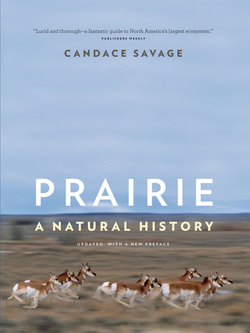Читать книгу Prairie - Candace Savage - Страница 41
На сайте Литреса книга снята с продажи.
ОглавлениеPrairie grasses ride this climatic roller coaster with composure. Species that couldn’t stay the course fell into extinction in ages long past, leaving behind the modern community of hardy survivors. Each of these successful species has been further refined over the past several thousand years, producing subspecies, or varieties, that are finely attuned to local conditions. A native grass from Alberta, for example, typically achieves maturity in a matter of weeks, fitting its life cycle to the abbreviated growing season of the northern plains. But a clump of the same species from Missouri or Oklahoma is programmed to take its time, pacing its activities to the more leisurely schedule of southern climes. These kinds of local, genetic differences have been detected in a wide range of native grasses, including blue grama, its cousin sideoats grama, the compact-and-graceful June grass, switchgrass, and both big and little bluestem. Natural selection, that master gardener, has been at work on them.
The one climatic factor that presents a continuing challenge for prairie grasses is the moisture supply. Over the Great Plains as a whole, precipitation is more variable than it is almost anywhere else on the continent, with years that are both much wetter and much drier than the long-term norm. (One study of precipitation records in western Kansas, for example, showed that in most months the amount of moisture received was either significantly below or significantly above average. Only “normal” values were truly abnormal.) When the rains are generous, the prairie flourishes and blooms; but when drought sets in, the grasses—indeed the whole ecosystem—are severely tested. More than any other single factor, the limits to growth on the prairies are set by precipitation.
> ANCESTRAL ECHOES
Several million years ago, perhaps about the time when miniature rhinos and dog-sized horses were roaming across the prehistoric savannas of the Great Plains, life was confronted by a major challenge. For some unknown reason, the concentration of carbon dioxide in the atmosphere had begun to drop—so much so that certain plants were left gasping for breath. Without adequate carbon dioxide, they could not easily carry out the life-giving process of photosynthesis.
Some of the afflicted plants, including several families of grasses, responded to this crisis with a major innovation, the invention of a completely new method of photosynthesis. Unlike the old, so-called C3 pathway, which had chugged along for millennia by linking carbon atoms in three-atom molecules, the new, improved C4 model produced more carbohydrates from the same amount of carbon dioxide by linking carbon in four-carbon molecules. But to achieve this enhancement, the plants relied on an enzyme that required relatively high temperatures, with an ideal range between 75˚F and 85˚F (25˚c and 30˚c ), up from the old standard of 65˚F to 75˚F (20˚c to 25˚c ).
Although carbon dioxide levels eventually recovered from their slump, C4 photosynthesis proved to be so successful that it has survived to the present day, alongside the tried-and-true C3 technology. Today, C4 grasses—including blue grama, sand drop-seed, big and little bluestem, and corn—are found throughout the prairies and are especially dominant on the southern plains (where heat and moisture are abundant at the height of the growing season). Because of their temperature requirements, they generally grow and set seed in mid to late summer and hence are known as “warm-season” grasses. The C3, or “cool-season” grasses, by contrast—including needle-and-thread, western wheatgrass, and wheat itself—typically produce seed early in the summer before the temperatures hit their peak. Since in nature C3 and C4 grasses typically occur in mixed stands, they are able to share scarce water by pulsing their demands.
Why So Dry?
